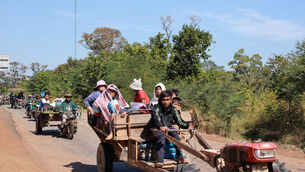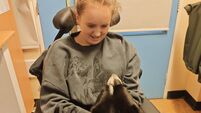Herman goes back to work
Herman, the world’s first farm animal carrying a human gene, sired 55 calves and outlived them all.
But just when the test-tube bull thought he had seen everything, his sponsor ran out of money.
Instead of retirement on a comfortable bed of straw listening to rap music, Herman now has to make a living again.
He will star at a permanent biotech exhibition in Naturalis, a natural history museum in the Dutch city of Leiden. After his death, he will be stuffed and remain in the museum in perpetuity.
Two new corporate sponsors will pay €45,000 per year for his food, rent, and his caretaker’s salary.
They will also cover the costs to house the world’s first cloned cows, Holly and Belle, which also will move to Naturalis.
Strolling in his spacious 430 sq ft stall, the 11-year-old bull seemed content, even playful, unaware he had only a few months left on the farm where he has been since 1994. Holly and Belle share a space half that size.
‘‘Herman is pampered,’’ said Marije de Vos, his caretaker. ‘‘But he is our little star. He has an extra large stall, sleeps on a thicker pile of straw and gets brushed everyday.’’
The massive 2,500lbs beast, with black eyepatches on a white face and stubby horns, nuzzles his minder with affection through his stall’s metal bars. Full-grown bulls are rare in this dairy-producing country, where most cattle go to the abattoir at the age of four.
From the back of the stall comes an uninterrupted flow of music, mostly rap.
‘‘He has been listening to this channel round-the-clock since he arrived here,’’ said de Vos. ‘‘It makes Herman calm.’’
De Vos became Herman’s caretaker after Pharming Group NV, the Leiden-based biotechnology firm that created him in 1990, ended the programme for which he was born.
Though he looks ordinary, Herman carries an extra gene modified from human material. The gene, which was injected in a laboratory at the early embryo stage, bears codes that produce a human milk protein called lactoferrin in his female offspring. Lactoferrin is an iron-rich protein that kills germs and stops or prevents infections.
Pharming found that the level of human lactoferrin in the milk of his daughters was too low and the cost to extract it was too high to be commercially viable.
Further experiments led to the production of other cows that are transgenic - bearing genes from another species - with better lactoferrin production. However, it will take several more years of trials before health authorities approve lactoferrin for public use.
In the meantime, Pharming has shifted its focus to other transgenic animals producing human proteins, such as rabbits.
The 55 offspring that Herman produced were all killed and destroyed after the end of the experiment, in line with Dutch health legislation.
Herman was also slated for the abattoir, but the Dutch public - proud of making history with Herman - rose up in protest, especially after a television programme screened footage showing the amiable bull licking a kitten. Herman won a bill of clemency from parliament.
But the government ordered Herman, a cross between Zwartbont Holstein Frisian and Groninger Blaarkop, to be castrated.
Pharming agreed to sponsor Herman’s retirement for its advertising. But he was again found to be expendable when the company launched a restructuring scheme and filed for bankruptcy protection last August.
The technology company Nedap NV and the Yarden insurance company decided to adopt Herman and his cloned neighbours until their natural deaths.
The Animal Protection Group, which opposes genetically engineered animals, is unhappy with the solution.
‘‘It’s ethnically not right to exploit him in a museum,’’ said spokeswoman Maaike Wermer.
De Vos agrees. ‘‘Herman is used to the peace here. I don’t know if he can still handle a move like this at his age,’’ she said.













